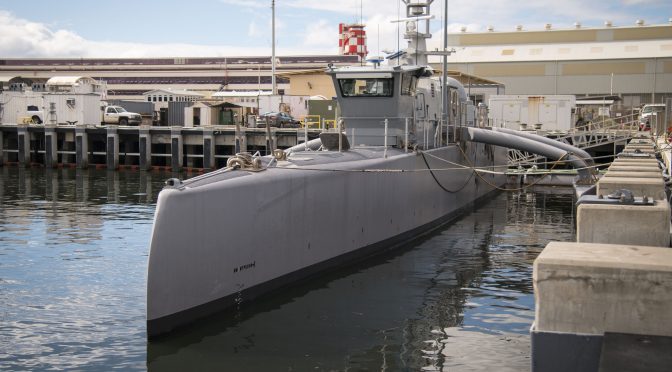By Dmitry Filipoff
Last week CIMSEC published articles submitted in response to our call for articles released in partnership with the Navy’s Unmanned Maritime Systems program office. Authors discussed how to experiment with unmanned systems, how unmanned systems can contribute to amphibious assaults and fleet air defense, among other operational and developmental questions. We thank the authors for their excellent contributions.
“Create an Unmanned Experimental Squadron and Learning System” by Dustin League and LCDR Daniel Justice
“…we propose that the Navy revisit history and revitalize the complex learning system it used to exploit an earlier set of new capabilities prior to World War II. Specifically, we call for the Navy to accelerating standing up a dedicated experimental squadron with the purpose of exploring advanced tactics for employing unmanned systems in a series of tactically challenging, objective-based exercises.”
“Unmanned Units Need Tenders for Distributed Operations” by Griffin Cannon
“Looking to the past, the precedent of the Pacific War, in which fleet tenders provided engineering support to a mobile fleet, suggests a path forward. Basing a support and sustainment model for Unmanned Surface Vehicles (USVs) on 21st century tenders would both fulfill the unique support needs of USVs and help build the ability to fight and deter a war in the Pacific.”
“Autonomous Pickets for Force Protection and Fleet Missile Defense” by 1st Lt. Walker D. Mills
“In all cases, the ability to form a protective perimeter of unmanned systems beyond the edge of the fleet would significantly boost survivability and increase options for the fleet commander by lowering risk. A flotilla of autonomous pickets, armed with effective CIWS and multi-spectrum missile countermeasures, can function as a powerful yet affordable force multiplier. Such a force would provide the Navy with an increased ability to operate and project power inside an anti-access, area-denial (A2/AD) network and help the fleet weather storms of missile salvos. “
“Accelerating the Renaissance of the U.S. Navy’s Amphibious Assault Forces” by George Galdorisi
“The ship-to-shore movement of an expeditionary assault force was—and remains—the most hazardous mission for any navy. The value of real-time ISR and IPB is difficult to overstate. It is this ability to sense the battlespace in real time that will spell the difference between victory and defeat. For this reason, it seems clear that the types of unmanned systems the Department of the Navy should acquire are those systems that directly support naval expeditionary forces that conduct forcible entry operations. “
“Providing Secure Logistics for Amphibious Assault with Unmanned Surface Vehicles” by Neil Zerbe
“…the Navy would be better served by embracing the always successful “crawl, walk, run,” method and use commercial off-the-shelf technology to evolve an already proven logistics capability before committing to ambitious plans with unmanned surface ships that aren’t yet on the drawing boards. Far from distracting Navy officials from these more lofty ideas for using unmanned systems, demonstrating this capability in Navy-Marine Corps exercises would likely accelerate the Navy’s embrace of unmanned systems.”
“The Case for Unmanned Surface Vehicles in Future Maritime Operations” by Wayne Prender
“While it is encouraging to see Navy plans to move quickly to bring initial Medium and Large USVs into the fleet, other unmanned platforms are equally ready for such an approach. Innovation is the key to shaping tomorrow’s Navy, and getting USVs of all shapes and sizes to the fleet for Sailors to try out is the best approach to achieving it.”
Dmitry Filipoff is CIMSEC’s Director of Online Content. Contact him at Nextwar@cimsec.org.
Featured Image: PEARL HARBOR (Nov. 2, 2018) The medium displacement unmanned surface vehicle (MDUSV) prototype Sea Hunter is moored onboard Joint Base Pearl Harbor-Hickam, Hawaii. Sea Hunter’s arrival in Hawaii demonstrates that MDUSVs are capable of deployed blue-water operations, enabling a new class of naval system. Highly autonomous USVs like Sea Hunter are creating a new paradigm for Navy surface forces, as they are capable of carrying a variety of payloads and performing many missions, including independent operations from manned Navy ships. (U.S. Navy photo by Mass Communication Specialist 1st Class Nathan Laird/Released)

